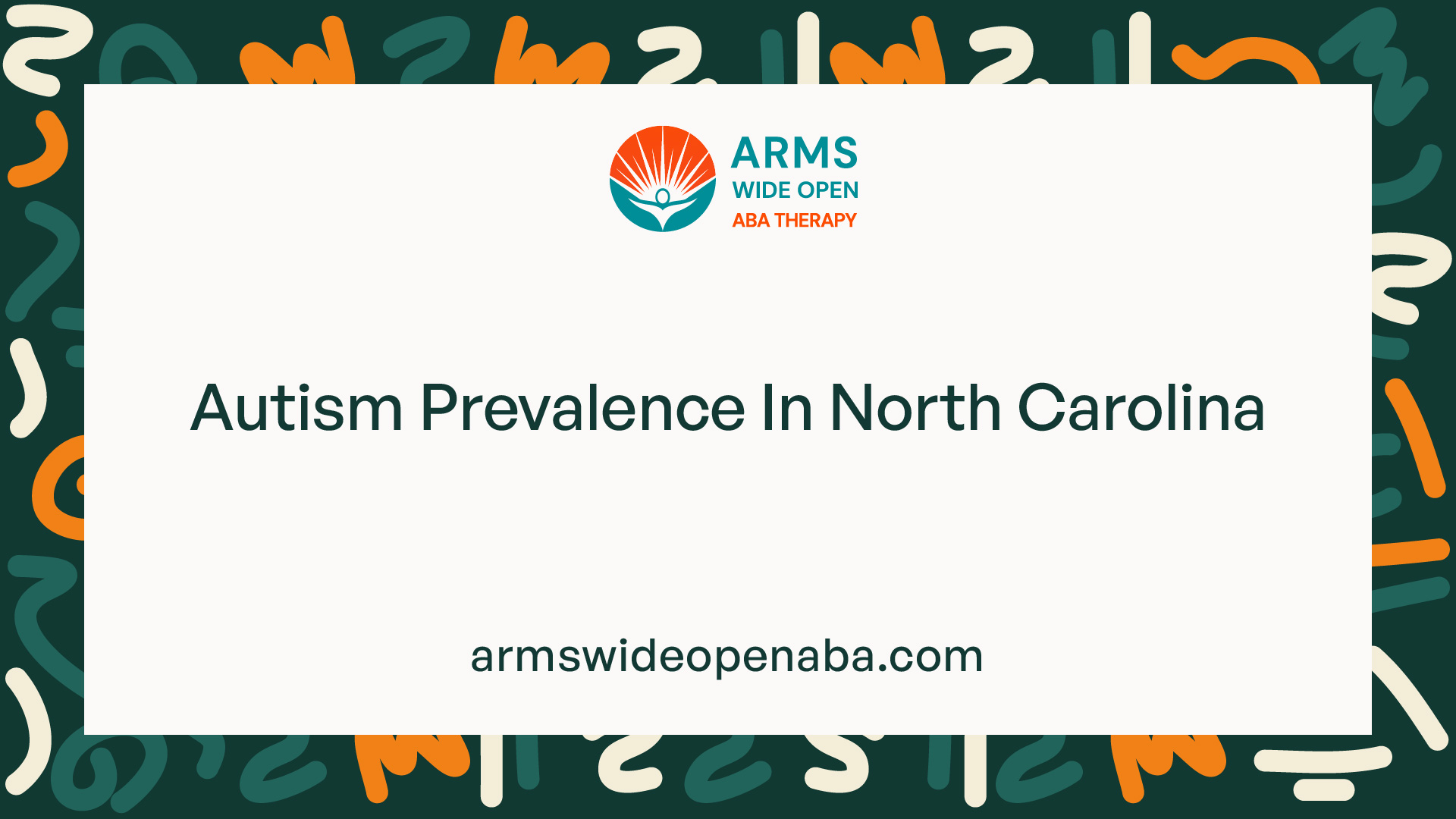Autism Prevalence In North Carolina
Unveiling autism prevalence in North Carolina. Dive into factors, challenges, and initiatives shaping the future.

Understanding Autism Prevalence
In order to comprehend the prevalence of autism in North Carolina, it is important to first gain an understanding of autism spectrum disorder (ASD) and the factors that influence prevalence rates.

Defining Autism Spectrum Disorder
Autism Spectrum Disorder (ASD) is a neurodevelopmental disorder characterized by challenges in social interaction, communication, and restricted or repetitive behaviors. It is a spectrum disorder, meaning that it affects individuals in different ways and to varying degrees. Symptoms typically appear in early childhood and can persist into adolescence and adulthood.
ASD encompasses a wide range of conditions, including autistic disorder, Asperger's syndrome, and pervasive developmental disorder not otherwise specified (PDD-NOS). The Diagnostic and Statistical Manual of Mental Disorders (DSM-5) provides the diagnostic criteria used by healthcare professionals to identify individuals with ASD.
Factors Influencing Prevalence Rates
Several factors can influence the prevalence rates of autism in a given population. These factors include:
- Diagnostic Criteria and Practices: Changes in diagnostic criteria and improved awareness among healthcare professionals can lead to higher prevalence rates. As diagnostic methods become more refined and comprehensive, more individuals with ASD are identified.
- Increased Awareness and Screening: Greater awareness of autism and increased screening efforts in communities can lead to earlier identification and diagnosis. This can contribute to higher prevalence rates as more individuals with ASD are identified.
- Improved Access to Services: Availability and access to appropriate healthcare services, including diagnostic evaluations and interventions, can impact the identification and prevalence rates of autism. Improved access to services ensures that individuals with ASD are more likely to be diagnosed and receive the support they need.
- Environmental and Genetic Factors: Research suggests that both genetic and environmental factors may play a role in the development of autism. Genetic predisposition, combined with environmental influences, can contribute to the prevalence of the disorder.
It is important to consider these factors when examining the prevalence of autism in North Carolina. By understanding the definition of autism spectrum disorder and the various factors that contribute to prevalence rates, we can gain a deeper insight into the context of autism in the state.
Autism in North Carolina
Autism prevalence in North Carolina is a significant topic of interest when examining the overall landscape of autism spectrum disorder (ASD) in the state. Understanding the prevalence rates can provide valuable insights into the scope of the condition and the need for resources and support. Accurate prevalence data is crucial for policymakers, healthcare providers, educators, and families to make informed decisions and allocate appropriate resources to support individuals with ASD.
North Carolina has been actively involved in autism research and has contributed to national prevalence studies. The state has participated in the Autism and Developmental Disabilities Monitoring (ADDM) Network, a nationwide effort to estimate the prevalence of ASD among children aged 8 years old. The most recent ADDM report, released in 2020, estimated that 1 in 39 children in North Carolina were identified with ASD, which is higher than the national average of 1 in 54.
Contributing Factors
When it comes to understanding the prevalence of autism in North Carolina, several contributing factors play a significant role. These factors include diagnostic criteria and awareness, as well as access to services and support.
Diagnostic criteria for ASD have evolved over time, with the most recent changes reflected in the Diagnostic and Statistical Manual of Mental Disorders, Fifth Edition (DSM-5). These changes have aimed to improve the accuracy and consistency of ASD diagnoses. In North Carolina, healthcare providers and clinicians have been adapting to these criteria, which may have an impact on the reported prevalence rates.
Increased awareness and understanding of ASD have also contributed to higher prevalence rates. As more people become knowledgeable about the signs and symptoms of autism, more children are likely to be identified and diagnosed. North Carolina has made efforts to raise awareness through various initiatives, such as the North Carolina Autism Alliance and the North Carolina Autism Society.
Access to services and support is another crucial factor in understanding autism prevalence in North Carolina. The state has a network of resources available for individuals with ASD and their families, including the TEACCH Autism Program at the University of North Carolina at Chapel Hill, which provides diagnostic evaluations, treatment recommendations, and support services. However, disparities in access to these resources may exist, particularly in rural or underserved areas of the state.
Diagnostic Criteria and Awareness
The diagnostic criteria for autism spectrum disorder (ASD) have evolved over time, leading to changes in the identification and diagnosis of individuals with autism. With increased awareness and understanding of the disorder, more accurate and earlier diagnoses can be made.
In recent years, there has been a heightened focus on early identification of autism, which has contributed to the rising prevalence rates. Healthcare providers, educators, and parents are becoming more knowledgeable about the signs and symptoms of autism, leading to earlier referrals for assessments and evaluations.
The increased awareness of autism has also helped reduce the stigma associated with the disorder, encouraging individuals and families to seek the necessary support and services. This has resulted in a more accurate representation of autism prevalence rates.
Access to Services and Support
Access to appropriate services and support is crucial for individuals with autism and their families. In North Carolina, efforts have been made to improve access to autism-related services, including early intervention programs, behavioral therapies, and educational resources.
The availability of diagnostic centers and specialized clinics has increased, allowing for timely evaluations and interventions. Additionally, schools have implemented programs to support students with autism, ensuring that they receive the necessary accommodations and interventions to thrive academically and socially.
To address the needs of individuals with autism, North Carolina has also established various initiatives and organizations. These resources provide information, guidance, and support to individuals with autism and their families, helping them navigate the challenges associated with the disorder.
Despite these advancements, it is important to note that disparities in access to services and support still exist. Factors such as geographical location and socioeconomic status can impact the availability and affordability of autism-related resources. Continued efforts are needed to ensure equitable access to services for all individuals with autism across North Carolina.
By recognizing the importance of diagnostic criteria and awareness, as well as access to services and support, we can better understand the contributing factors behind the prevalence of autism in North Carolina. These factors shape the landscape of autism care and influence the lives of individuals with autism and their families in the state.
Addressing the Needs
Individuals with autism face unique challenges that require specific support and resources. In North Carolina, efforts are being made to address these needs and provide a supportive environment for individuals with autism and their families.
Challenges Faced by Individuals with Autism
People with autism may encounter various challenges in their daily lives. These challenges can include difficulties with communication, social interaction, sensory sensitivities, and repetitive behaviors. Additionally, individuals with autism may face challenges in accessing appropriate educational and healthcare services, as well as employment opportunities.
Understanding and addressing these challenges is crucial to ensure that individuals with autism can lead fulfilling lives. By providing appropriate support and accommodations, we can help individuals with autism overcome these challenges and reach their full potential.
Resources and Initiatives in North Carolina
North Carolina is committed to providing resources and initiatives to support individuals with autism and their families. The state offers a range of programs and services aimed at improving the quality of life for individuals with autism, including:

By providing these resources and initiatives, North Carolina is working towards creating a more inclusive and supportive environment for individuals with autism. These efforts help to address the needs of individuals with autism and ensure that they have access to the support and services necessary to thrive in all aspects of life.
Future Outlook
As we look to the future, it's important to consider the trends in autism prevalence and the efforts being made for early detection and intervention. These factors play a crucial role in supporting individuals with autism and their families.
Recent studies have shown a steady increase in autism prevalence rates over the past few decades. While some of this increase can be attributed to improved diagnostic criteria and increased awareness, researchers are also investigating potential environmental and genetic factors that may contribute to the development of autism spectrum disorders.
Early detection and intervention are key to providing the best possible outcomes for individuals with autism. With advancements in screening tools and a growing understanding of early signs and symptoms, healthcare professionals are becoming better equipped to identify autism in young children. This allows for timely access to specialized therapies and support services that can help children with autism develop crucial skills and reach their full potential.
Furthermore, ongoing research efforts are exploring new interventions and therapies to support individuals with autism throughout their lifespan. From behavioral therapies and educational strategies to medical treatments and assistive technologies, the field of autism research is constantly evolving to meet the diverse needs of this population.
As we move forward, it is crucial for society to prioritize inclusivity, acceptance, and understanding of individuals with autism. By creating supportive environments in schools, workplaces, and communities, we can help ensure that people with autism have the opportunities they need to thrive and lead fulfilling lives.
Collaboration between families, healthcare providers, educators, and policymakers will be essential in shaping a future where individuals with autism are empowered to reach their goals and contribute their unique talents to society. By working together and advocating for the needs of the autism community, we can create a brighter, more inclusive future for all.
Trends in Autism Prevalence
Autism prevalence rates have been on the rise in recent years, not just in North Carolina but across the United States. The Centers for Disease Control and Prevention (CDC) regularly monitors the prevalence of autism spectrum disorder (ASD) and publishes updated data. While the exact reasons for the increase in prevalence are still being studied, advancements in diagnostic criteria, increased awareness, and improved identification and reporting may contribute to these rising numbers.
The table below provides an overview of the prevalence rates in North Carolina:

Efforts for Early Detection and Intervention
Early detection and intervention play a vital role in supporting individuals with autism. Recognizing the signs of autism at an early age allows for timely access to appropriate services and support, increasing the chances of positive outcomes.
North Carolina has taken significant steps to enhance early detection and intervention efforts. The state has implemented various initiatives focused on increasing awareness among healthcare professionals, educators, and communities. These efforts aim to promote early identification of autism and ensure that children receive the necessary interventions as early as possible.
In addition to awareness campaigns, North Carolina has developed resources and programs to support families and individuals with autism. These include early intervention services, specialized educational programs, and community-based support networks. By providing comprehensive and accessible services, the state is working towards improving outcomes for individuals with autism and their families.
As research continues to advance our understanding of autism, it is crucial to stay informed about the latest trends in prevalence and to advocate for early detection and intervention. By addressing the needs of individuals with autism and fostering a supportive environment, we can create a more inclusive society that embraces and empowers individuals with autism to reach their full potential.
Sources
https://www.abtaba.com/blog/prevalence-in-north-carolina.
https://www.crossrivertherapy.com/autism/autism-prevalence-in-north-carolina
https://www.autismsociety-nc.org/signs-statistics/
Similar articles
We’re here to help you

Our team is here to assist you in this process. Contact us for any assistance.
it’s easy to apply
We Accept Most Insurances
Our in-network insurance partnerships make ABA therapy more accessible to families throughout our service areas.







Our Insurance Process
We'll request your insurance details to help us verify your plan's coverage for ABA therapy. Once we've received this information, we'll walk you through your benefits, including copayments, deductibles and out-of-pocket maximums, so you know what to expect in advance.
Our team will then handle the preauthorization and all the necessary paperwork.
.svg)





















.jpeg)


































.jpeg)




.jpeg)







.jpeg)











.jpeg)
















